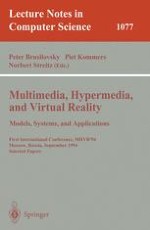1996 | Buch
Multimedia, Hypermedia, and Virtual Reality Models, Systems, and Applications
First International Conference, MHVR'94 Moscow, Russia, September 14–16, 1994 Selected Papers
herausgegeben von: Peter Brusilovsky, Piet Kommers, Norbert Streitz
Verlag: Springer Berlin Heidelberg
Buchreihe : Lecture Notes in Computer Science
Enthalten in: Professional Book Archive
